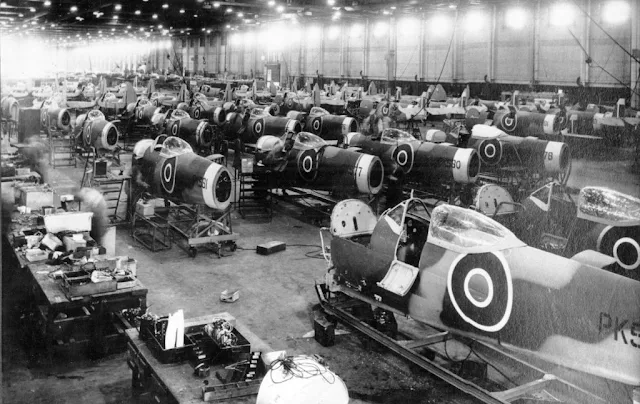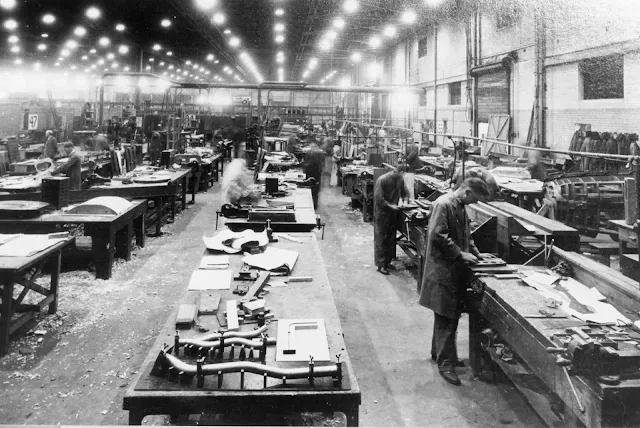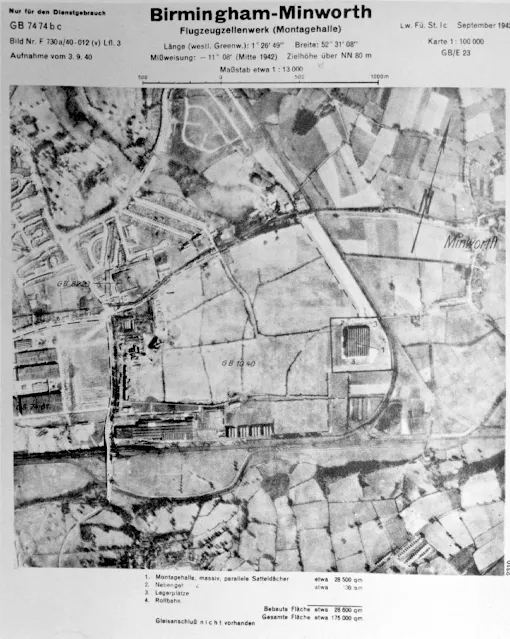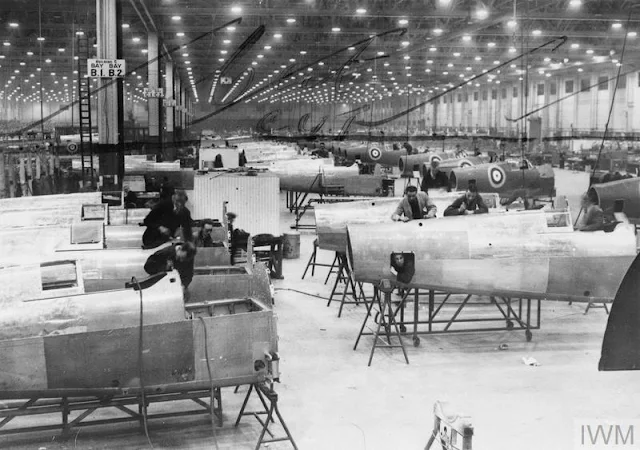 |
| A finished Lancaster is ready to be rolled out from Block 'A' |
Nuffield: 1936–1940
In 1936, the British government had formalized a plan under
the Air Ministry called the Shadow factory plan to increase capacity within
Britain's aircraft industry. Headed up by automotive pioneer Herbert Austin,
the plan was to create nine new factories and add additional capacity and
facilities to Britain's existing car manufacturing plants to enable them to
quickly turn to aircraft production should the political situation in Europe
change towards war.
In 1936, the Air Ministry purchased a parcel of land
opposite Castle Bromwich Aerodrome which encompassed an old sewage works.
Developed and managed by the Nuffield Organization, owners of Morris Motors,
they were briefed to manufacture Supermarine Spitfire fighters and later Avro
Lancaster bombers. The theory was that the local Birmingham skills-base and production
techniques used in the manufacture of motor vehicles could be transferred to
aircraft production.
CBAF ordered the most modern machine tools then available
which were being installed two months after work started on the site. Although
Morris Motors under Lord Nuffield (an expert in mass motor-vehicle
construction) managed and equipped the factory, it was funded by government
money. When the project was first mooted, it was estimated that the factory
would be built for £2,000,000, however, by the beginning of 1939, this cost had
doubled to over £4,000,000. The Spitfire's stressed-skin construction required
precision engineering skills and techniques outside the experience of the local
labor force which took some time to train. Aircraft and sub-assemblies were
taken across the Chester Road to Castle Bromwich Aerodrome; though early plans
included an aerial bridge from E block to the airfield. Very large hangar-like
buildings were erected on the east side of the airfield, which were originally
referred to as 'Erecting Sheds', where aircraft were prepared for flight
testing. They were for the most part referred to by personnel as the 'Flight
Sheds'.
CBAF's chief test pilot was Alex Henshaw MBE who managed a
team of pilots who had the job of flight-testing the aircraft. The Air
Transport Auxiliary were responsible for dispersing tested machines to the
Maintenance Units around the country for the fitting of radio-telephones and
other equipment. As any build-up of machines on the airfield would be vulnerable
to aerial attack, testing was carried out during daylight in almost any
weather.
CBAF produced all versions of the Spitfire from the Mk II
onwards. This aircraft had the more powerful Rolls-Royce Merlin XII engine,
providing 1,150 horsepower (860 kW), an increase of 120 horsepower (89 kW) over
the Mk I, and could be used with either the de Havilland or Rotol propellers.
The first Mk II flew on 24 September 1939.
However, even as the first Spitfires were being built in
June 1940, the factory was still incomplete and there were numerous problems
with the factory management which ignored tooling and drawings provided by
Supermarine in favor of tools and drawings of its own designs. Meanwhile, the
workforce, while not completely stopping production, continually threatened
strikes or "slow downs" until their demands for higher than average
pay rates were met. By May 1940, Castle Bromwich had not yet built its first
Spitfire in spite of promises that the factory would be producing 60 per week starting
in April.
Key players, such as Alex Henshaw, viewed the problems as
primarily those of poor management during the initial phase. Workers worked
twelve-hour on and twelve-hours off until bombings forced a switch to a
three-shift, eight-hour system. Henshaw attended the diamond jubilee in 1996 of
the founding of the CBAF, hosted by Jaguar Cars Limited in the old factory and
remained fulsome in his praise for the workforce until his death.
Vickers-Armstrong: 1940–1945
After the fall of the government of Neville Chamberlain, new
Prime Minister Winston Churchill appointed press tycoon Lord Beaverbrook as the
Minister of Aircraft Production. On 17 May, Beaverbrook telephoned Nuffield and
maneuvered him into handing over control of the Castle Bromwich plant to
Beaverbook's Ministry. Nuffield was furious and reported the incident to
Churchill, but Beaverbrook countered by sending in aircraft expert Sir Richard
Fairey who wrote a secret report which detailed how expensive machinery had
been unused, the assembly line in chaos, and the employees not doing their
work:
Labour
is in a very bad state. Discipline is lacking. Men are leaving before time and
coming in late, taking evenings off when they think fit. In parts of the
factory I noticed that the men did not even stir themselves at the approach of
the Works Manager. The labour in the Midlands is not “playing the game”. They
are getting extra money and are not working in proportion for it.
Beaverbrook, who had disturbed the Air Ministry by agreeing
with the vision of Air Vice Marshal Hugh Dowding that Britain at that time
needed defensive fighters over attacking bombers, immediately cancelled all
Castle Bromwich contracted bombers, which at that point included the
Handley-Page Halifax and the Vickers Wellington. He then sent in experienced
management staff and workers from Supermarine, and gave over control of the
factory to Vickers-Armstrong (Supermarine's parent company). Although it would
take some time to resolve the problems, CBAF achieved full production in June
1940, when 10 Spitfire Mk IIs were built; 23 in July; 37 in August; and 56 in
September. No. 611 Squadron at RAF Digby the first squadron to receive the Mk
II in August 1940, notably late in the Battle of Britain.
The wisdom of the shadow factory scheme was demonstrated in
September 1940, when the Supermarine factory in Southampton was bombed, and
production there temporarily stopped. CBAF went on to become the largest and
most successful plant of its type during the 1939–45 conflict. As the largest
Spitfire factory in the UK, by producing a maximum of 320 aircraft per month,
it built over half of the approximately 20,000 aircraft of this type. By the
time production ended at Castle Bromwich in June 1945, a total of 12,129 Spitfires
(921 Mk IIs, 4,489 Mk Vs, 5,665 Mk IXs, and 1,054 Mk XVIs) had been built.
Subsequently receiving an order for 200 production aircraft,
the first CBAF Lancaster was flown on 22 October 1943 by Alex Henshaw. Given
the airframe number HK535 and fitted with Merlin 22 engines, it was issued to
No. 463 Squadron Royal Australian Air Force. It was lost on a raid over Lille,
France, during the night of 10/11 May 1944. Production of Lancasters reached a
peak of 25 in December 1944, a record for the quantity produced anywhere.
The film Jane Brown Changes Her Job (1941) was made in the
factory, and scenes for the 1943 film Millions Like Us were shot there, with
employees serving as extras.
Some original wartime features can still be seen such today,
such as the faded remains of green camouflage paint. This can still be seen on
the top of some older production buildings, such as F Block, that is now used
as trim and final assembly for the Jaguar XJ. Close inspection will also reveal
that all the cast-iron hoppers of the factory's rainware have a winged-roundel
motif cast into them. At the Jubilee celebrations in 1997, a plaque was
unveiled by Alex Henshaw just inside the old wartime main gates to the factory
site. At the moment of unveiling, ex-Red Arrows founder Ray Hanna made a single
pass over the ceremony in a Spitfire MkIX, MH434. This aircraft was not only
built at the CBAF, but was test-flown by Henshaw himself. The aircraft had been
specially named for the occasion by Henshaw at Elmdon Airfield (now called
Birmingham International Airport). After the unveiling, both Henshaw and Hanna
attended a celebratory luncheon with many local dignitaries and many former
CBAF employees. The whole event was supported and funded by Jaguar Cars Ltd.
 |
| Castle Bromwich - B Block construction June 1939. |
 |
| Winston Churchill chats with Alex Henshaw at Castle Bromwich. |
 |
| Bomb damage to D Block after raid - August 1940. |
 |
| Production of Lancaster nose sections in Block A. |
 |
| Supermarine Spitfire Mk IIA (Royal Air Force code P7350) at Kemble Air Day, Kemble Airport, Gloucestershire, England. Owned by the UK Battle of Britain Memorial Flight. Quote from the BBMF website: P7350 is the oldest airworthy Spitfire in the world and the only Spitfire still flying today to have actually fought in the Battle of Britain. She is believed to be the 14th aircraft of 11,989 built at the Castle Bromwich ‘shadow' factory, Birmingham. Entering service in the August of 1940, she flew in the Battle of Britain serving with 266 Squadron and 603 (City of Edinburgh ) AuxAF Squadron. (Adrian Pingstone) |
 |
| Castle Bromwich Aircraft Factory, heavily camouflaged. |
 |
| The Prime Minister Winston Churchill observes a female riveter working on a Supermarine Spitfire at the Castle Bromwich factory in Birmingham, England, on 28 September 1941. (Imperial War Museum H14259) |
.jpg) |
| The flight line at Castle Bromwich in 1944 with massed Spitfire IXs and two Lancasters. |
.jpg) |
| Tropical filter-fitted Spitfire V ER810 at Castle Bromwich in October 1942. It carries the name ‘Inca’ on the forward fuselage, funded by the people of Lima, Peru |
.jpg) |
| Final assembly, C Block Castle Bromwich Aircraft Factory, circa 1943. (Birmingham Museums Trust) |
.jpg) |
| Spitfire F.22s on the line in late 1945. Many of these were completed and flight tested at Keevil or South Marston as Castle Bromwich production wound down. In the middle on the left is PK581, which was issued to the RAF in October 1945. |
.jpg) |
| Women workers preparing Spitfire parts for spraying. (Birmingham Museums Trust) |
.jpg) |
| Main drawing office, Castle Bromwich Aircraft Factory, c.1943. (Birmingham Museums Trust) |
 |
| Prime Minister Winston Churchill talking to Alex Henshaw, after a 1941 demonstration flight on a Spitfire. (Imperial War Museum H14264) |
 |
| The Sentinel monument on Spitfire Island, Castle Bromwich, Birmingham commemorates the manufacture of almost 12,000 Spitfire fighter aircraft by Vickers Armstrong at this site between 1940 and 1945. The sculpture was designed by Tim Tolkien, great nephew of J R R Tolkien author of The Lord of the Rings and was unveiled in October 2000 by Alex Henshaw the former chief test pilot at Castle Bromwich aerodrome. |
 |
| Drying a Spitfire wing leading edge after painting with a barrage of infrared lights. |
 |
| Women hand-sewing Spitfire rudders at the Castle Bromwich Aircraft Factory. |
 |
| The pattern makers’ shop; working on items for Lancasters as well as Spitfires. |
 |
The main works canteen.
|
 |
| Fuselage jigs in the foreground with completed and painted fuselages behind. |
 |
| Castle Bromwich test pilots, left to right: Flt Lt J Rosser, Alex Henshaw, Norwegian Captain Olav Ullstad and Czechoslovakian Flt Lt Venda Jicha. |
 |
| The flight sheds, looking east. |
 |
| Birmingham was blitzed by the Luftwaffe several times from 1940 through to 1943, with horrific loss of life and property. The Castle Bromwich Aircraft Factory (CBAF) was on the receiving end on the night of August 13/14, 1940, just a fraction of the damage is illustrated. Seven people perished in the raid and another 41 were badly injured, but production was hardly interrupted. |
 |
| A Luftwaffe target chart (above), dated September 3, 1940 was probably taken for post-raid damage assessment and it was updated in September 1942. Clear on the chart is the railway line running from the northwest, with one section taking a sharp curve to the east, in the direction of central Birmingham. This acted as the eastern and southern boundary of the airfield and factory site. Wending its way across the middle of the target, and forming the northern boundary, is the Birmingham and Fazeley Canal. On the extreme lower left is part of the huge CBAF site and to the right of that the British Industries Fair building. |
 |
| Castle Bromwich: The grass field site prior to the start of construction 1937. |
 |
| Main gate entrance, Castle Bromwich Aircraft Factory. |
 |
| Spitfire assembly, Castle Bromwich Aircraft Factory. |
 |
| Women on the Spitfire production line. |
 |
| Aircraft at the Castle Bromwich plant. |
 |
| Spitfires come off the production line. |
 |
Spitfire Production at Castle Bromwich, 1940. Painting by Roy Garner. Jaguar Daimler Heritage Trust
|
 |
| Spitfire Production: A general view of the factory floor where Spitfire fuselages are under construction at an aircraft factory in the Midlands. (Imperial War Museum HU89805) |






.jpg)
.jpg)
.jpg)
.jpg)
.jpg)


















.jpg)


































